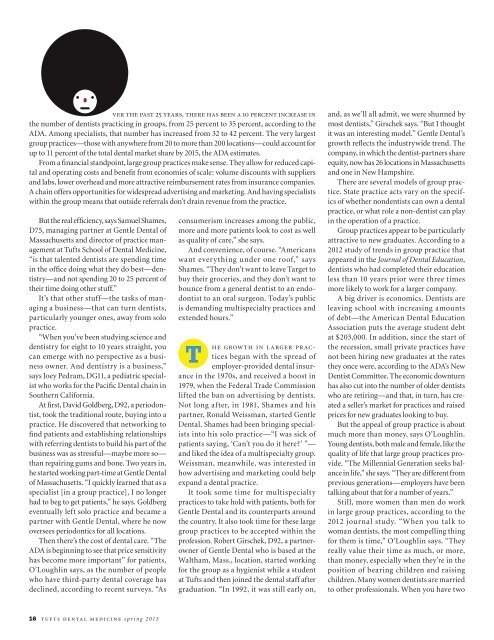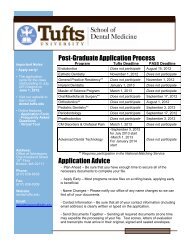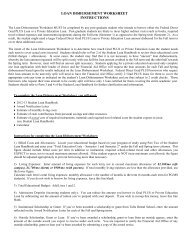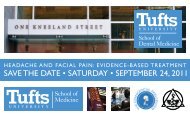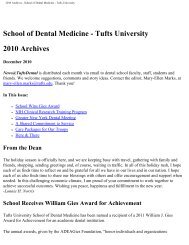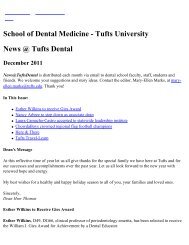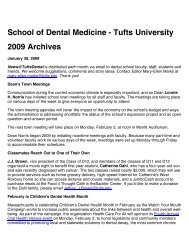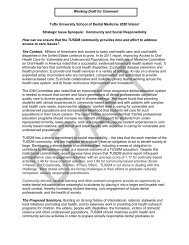Spring 2013 - Tufts University School of Dental Medicine
Spring 2013 - Tufts University School of Dental Medicine
Spring 2013 - Tufts University School of Dental Medicine
Create successful ePaper yourself
Turn your PDF publications into a flip-book with our unique Google optimized e-Paper software.
ver the past 25 years, there has been a 10 percent increase in<br />
the number <strong>of</strong> dentists practicing in groups, from 25 percent to 35 percent, according to the<br />
ADA. Among specialists, that number has increased from 32 to 42 percent. The very largest<br />
group practices—those with anywhere from 20 to more than 200 locations—could account for<br />
up to 11 percent <strong>of</strong> the total dental market share by 2015, the ADA estimates.<br />
From a financial standpoint, large group practices make sense. They allow for reduced capital<br />
and operating costs and benefit from economies <strong>of</strong> scale: volume discounts with suppliers<br />
and labs, lower overhead and more attractive reimbursement rates from insurance companies.<br />
A chain <strong>of</strong>fers opportunities for widespread advertising and marketing. And having specialists<br />
within the group means that outside referrals don’t drain revenue from the practice.<br />
But the real efficiency, says Samuel Shames,<br />
D75, managing partner at Gentle <strong>Dental</strong> <strong>of</strong><br />
Massachusetts and director <strong>of</strong> practice management<br />
at <strong>Tufts</strong> <strong>School</strong> <strong>of</strong> <strong>Dental</strong> <strong>Medicine</strong>,<br />
“is that talented dentists are spending time<br />
in the <strong>of</strong>fice doing what they do best—dentistry—and<br />
not spending 20 to 25 percent <strong>of</strong><br />
their time doing other stuff.”<br />
It’s that other stuff—the tasks <strong>of</strong> managing<br />
a business—that can turn dentists,<br />
particularly younger ones, away from solo<br />
practice.<br />
“When you’ve been studying science and<br />
dentistry for eight to 10 years straight, you<br />
can emerge with no perspective as a business<br />
owner. And dentistry is a business,”<br />
says Joey Pedram, DG11, a pediatric specialist<br />
who works for the Pacific <strong>Dental</strong> chain in<br />
Southern California.<br />
At first, David Goldberg, D92, a periodontist,<br />
took the traditional route, buying into a<br />
practice. He discovered that networking to<br />
find patients and establishing relationships<br />
with referring dentists to build his part <strong>of</strong> the<br />
business was as stressful—maybe more so—<br />
than repairing gums and bone. Two years in,<br />
he started working part-time at Gentle <strong>Dental</strong><br />
<strong>of</strong> Massachusetts. “I quickly learned that as a<br />
specialist [in a group practice], I no longer<br />
had to beg to get patients,” he says. Goldberg<br />
eventually left solo practice and became a<br />
partner with Gentle <strong>Dental</strong>, where he now<br />
oversees periodontics for all locations.<br />
Then there’s the cost <strong>of</strong> dental care. “The<br />
ADA is beginning to see that price sensitivity<br />
has become more important” for patients,<br />
O’Loughlin says, as the number <strong>of</strong> people<br />
who have third-party dental coverage has<br />
declined, according to recent surveys. “As<br />
consumerism increases among the public,<br />
more and more patients look to cost as well<br />
as quality <strong>of</strong> care,” she says.<br />
And convenience, <strong>of</strong> course. “Americans<br />
want everything under one ro<strong>of</strong>,” says<br />
Shames. “They don’t want to leave Target to<br />
buy their groceries, and they don’t want to<br />
bounce from a general dentist to an endodontist<br />
to an oral surgeon. Today’s public<br />
is demanding multispecialty practices and<br />
extended hours.”<br />
t<br />
he growth in larger practices<br />
began with the spread <strong>of</strong><br />
employer-provided dental insurance<br />
in the 1970s, and received a boost in<br />
1979, when the Federal Trade Commission<br />
lifted the ban on advertising by dentists.<br />
Not long after, in 1981, Shames and his<br />
partner, Ronald Weissman, started Gentle<br />
<strong>Dental</strong>. Shames had been bringing specialists<br />
into his solo practice—“I was sick <strong>of</strong><br />
patients saying, ‘Can’t you do it here’ ”—<br />
and liked the idea <strong>of</strong> a multispecialty group.<br />
Weissman, meanwhile, was interested in<br />
how advertising and marketing could help<br />
expand a dental practice.<br />
It took some time for multispecialty<br />
practices to take hold with patients, both for<br />
Gentle <strong>Dental</strong> and its counterparts around<br />
the country. It also took time for these large<br />
group practices to be accepted within the<br />
pr<strong>of</strong>ession. Robert Girschek, D92, a partnerowner<br />
<strong>of</strong> Gentle <strong>Dental</strong> who is based at the<br />
Waltham, Mass., location, started working<br />
for the group as a hygienist while a student<br />
at <strong>Tufts</strong> and then joined the dental staff after<br />
graduation. “In 1992, it was still early on,<br />
and, as we’ll all admit, we were shunned by<br />
most dentists,” Girschek says. “But I thought<br />
it was an interesting model.” Gentle <strong>Dental</strong>’s<br />
growth reflects the industrywide trend. The<br />
company, in which the dentist-partners share<br />
equity, now has 26 locations in Massachusetts<br />
and one in New Hampshire.<br />
There are several models <strong>of</strong> group practice.<br />
State practice acts vary on the specifics<br />
<strong>of</strong> whether nondentists can own a dental<br />
practice, or what role a non-dentist can play<br />
in the operation <strong>of</strong> a practice.<br />
Group practices appear to be particularly<br />
attractive to new graduates. According to a<br />
2012 study <strong>of</strong> trends in group practice that<br />
appeared in the Journal <strong>of</strong> <strong>Dental</strong> Education,<br />
dentists who had completed their education<br />
less than 10 years prior were three times<br />
more likely to work for a larger company.<br />
A big driver is economics. Dentists are<br />
leaving school with increasing amounts<br />
<strong>of</strong> debt—the American <strong>Dental</strong> Education<br />
Association puts the average student debt<br />
at $203,000. In addition, since the start <strong>of</strong><br />
the recession, small private practices have<br />
not been hiring new graduates at the rates<br />
they once were, according to the ADA’s New<br />
Dentist Committee. The economic downturn<br />
has also cut into the number <strong>of</strong> older dentists<br />
who are retiring—and that, in turn, has created<br />
a seller’s market for practices and raised<br />
prices for new graduates looking to buy.<br />
But the appeal <strong>of</strong> group practice is about<br />
much more than money, says O’Loughlin.<br />
Young dentists, both male and female, like the<br />
quality <strong>of</strong> life that large group practices provide.<br />
“The Millennial Generation seeks balance<br />
in life,” she says. “They are different from<br />
previous generations—employers have been<br />
talking about that for a number <strong>of</strong> years.”<br />
Still, more women than men do work<br />
in large group practices, according to the<br />
2012 journal study. “When you talk to<br />
woman dentists, the most compelling thing<br />
for them is time,” O’Loughlin says. “They<br />
really value their time as much, or more,<br />
than money, especially when they’re in the<br />
position <strong>of</strong> bearing children and raising<br />
children. Many women dentists are married<br />
to other pr<strong>of</strong>essionals. When you have two<br />
16 tufts dental medicine spring <strong>2013</strong>


